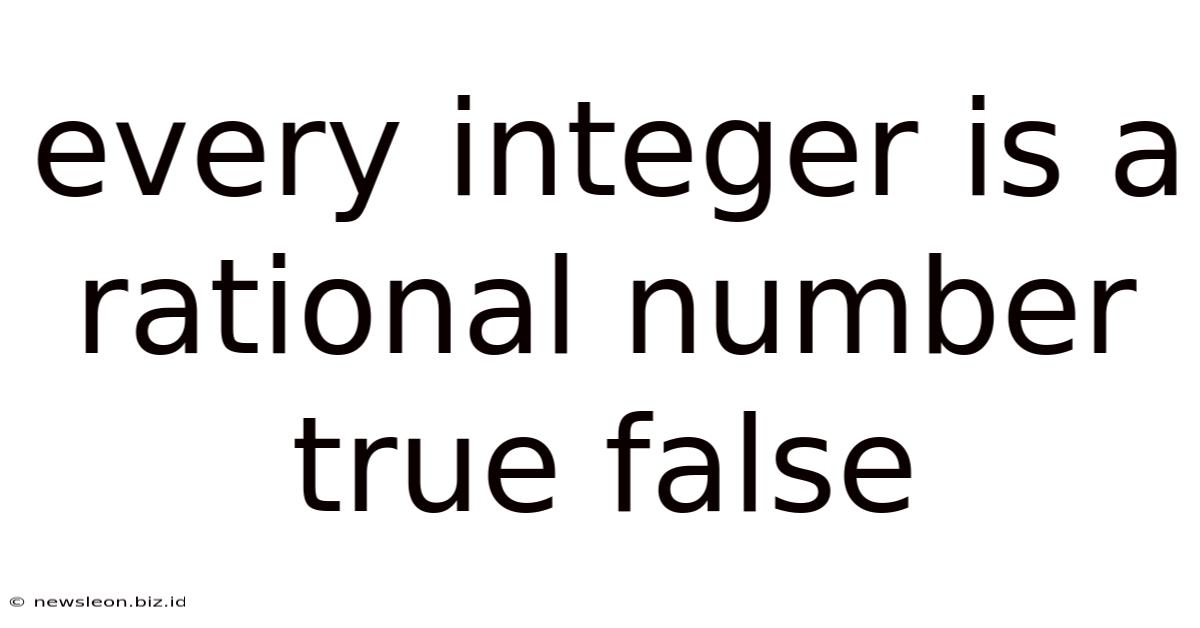Every Integer Is A Rational Number True False
News Leon
Apr 20, 2025 · 4 min read

Table of Contents
Every Integer is a Rational Number: True or False? A Deep Dive into Number Systems
The statement "Every integer is a rational number" is true. Understanding why requires a clear grasp of the definitions of integers and rational numbers, and the relationship between these fundamental number sets. This article will delve into these concepts, exploring the proof of this statement and clarifying any potential misconceptions. We'll also examine related number systems and their properties to solidify understanding.
Understanding Integers and Rational Numbers
Before we prove the statement, let's define our key terms:
Integers: The Whole Numbers and Their Opposites
Integers are whole numbers, including zero, and their negative counterparts. This set is represented as:
{... -3, -2, -1, 0, 1, 2, 3 ...}
Integers can be positive, negative, or zero. They form the basis of many mathematical operations and are crucial for understanding more complex number systems.
Rational Numbers: Fractions and Their Equivalents
Rational numbers are numbers that can be expressed as a fraction p/q, where 'p' and 'q' are integers, and 'q' is not equal to zero (q ≠ 0). This is a crucial condition; division by zero is undefined in mathematics. Examples of rational numbers include:
- 1/2: A simple fraction.
- -3/4: A negative fraction.
- 5: Can be expressed as 5/1.
- 0: Can be expressed as 0/1 (or 0/any non-zero integer).
- -2.5: Can be expressed as -5/2. Note that terminating and repeating decimals are also rational numbers.
The key characteristic of rational numbers is their ability to be represented as a ratio of two integers.
Proving that Every Integer is a Rational Number
The proof is straightforward and elegant:
Every integer 'n' can be expressed in the form n/1, where 'n' and '1' are both integers, and the denominator '1' is not zero. This perfectly fits the definition of a rational number (p/q, where p and q are integers, and q ≠ 0).
Therefore, every integer is a rational number.
Example Illustrations
Let's illustrate this with a few examples:
- The integer 5: Can be written as 5/1, which satisfies the definition of a rational number.
- The integer -3: Can be written as -3/1, fulfilling the rational number criteria.
- The integer 0: Can be written as 0/1, again fitting the definition.
In every case, the integer can be expressed as a fraction where both the numerator and denominator are integers, and the denominator is non-zero. This confirms the truth of the statement.
Expanding the Understanding: Irrational Numbers and the Real Number System
To fully appreciate the nature of rational numbers, it's helpful to consider the contrasting category: irrational numbers.
Irrational Numbers: Numbers that Cannot Be Expressed as Fractions
Irrational numbers are numbers that cannot be expressed as a fraction of two integers. They are non-repeating and non-terminating decimals. Famous examples include:
- π (pi): The ratio of a circle's circumference to its diameter, approximately 3.14159...
- e (Euler's number): The base of the natural logarithm, approximately 2.71828...
- √2 (the square root of 2): This number cannot be expressed as a simple fraction.
The Real Number System: Combining Rational and Irrational Numbers
The union of rational and irrational numbers forms the real number system. This system encompasses all numbers that can be plotted on a number line. The real number system is the foundation for much of advanced mathematics and is used extensively in scientific applications.
Addressing Potential Misconceptions
Some students might initially struggle with the concept that integers are a subset of rational numbers. This is because they might intuitively think of rational numbers solely as fractions. However, the definition clearly shows that integers are a special case of rational numbers—those with a denominator of 1.
It's also important to emphasize that not all rational numbers are integers. For example, 1/2 is a rational number, but it's not an integer. This illustrates the hierarchical relationship between these number sets: integers are a subset of rational numbers, which are in turn a subset of real numbers.
Practical Applications and Importance
The understanding of integers and rational numbers is foundational to many areas, including:
- Basic arithmetic: Adding, subtracting, multiplying, and dividing numbers requires a solid grasp of these concepts.
- Algebra: Solving equations and inequalities often involves manipulating integers and rational numbers.
- Calculus: Limits, derivatives, and integrals rely heavily on the properties of real numbers, including rational and irrational numbers.
- Computer Science: Representing and manipulating numbers in computer systems requires understanding number systems.
- Physics and Engineering: Many scientific calculations rely on precise numerical representation and manipulation.
Conclusion: A Foundation for Mathematical Understanding
The statement "Every integer is a rational number" is undeniably true. This seemingly simple statement highlights the important relationships between different number systems. By firmly grasping the definitions of integers and rational numbers, and understanding their interconnectedness within the broader real number system, one gains a crucial foundation for more advanced mathematical concepts. This foundational understanding is crucial for success in various fields, emphasizing the practical importance of this fundamental mathematical truth. The ability to identify, classify, and manipulate these numbers is a cornerstone of mathematical literacy and its applications in numerous disciplines.
Latest Posts
Related Post
Thank you for visiting our website which covers about Every Integer Is A Rational Number True False . We hope the information provided has been useful to you. Feel free to contact us if you have any questions or need further assistance. See you next time and don't miss to bookmark.